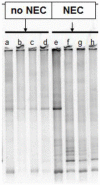Gram negative bacteria are associated with the early stages of necrotizing enterocolitis
- PMID: 21445365
- PMCID: PMC3062571
- DOI: 10.1371/journal.pone.0018084
Gram negative bacteria are associated with the early stages of necrotizing enterocolitis
Abstract
Introduction: Necrotizing enterocolitis (NEC) affects 5-10% of infants born weighing less than 1500 g. Most models of NEC recapitulate late-stage disease with gut necrosis and elevated inflammatory mediators. Evaluation of NEC at earlier, less lethal stages of disease will allow investigation of initial disease triggers and may advance our understanding of temporal relationships between factors implicated in NEC pathogenesis. In this manuscript, we describe our investigation of early NEC and test the hypothesis that bacteria and inflammatory mediators differ between animals with early NEC and disease free animals.
Methods: On DOL7 C3HeB/FeJ pups were fed liquid formula with 1×10(4) Streptococcus thoraltensis, Serratia marcescens, and Pseudomonas aeruginosa every 3 h. To initiate NEC, pups underwent asphyxia (100% N(2) for 90 s) and hypothermia (4°C for 10 min) after feeding. Pups were euthanized at 72 h. Intestines were collected for histologic NEC scoring and DNA/RNA extraction. Bacterial populations were identified by 16S rRNA pyrosequencing and principal component analysis (PCA). RNA isolates underwent QRT-PCR for Toll-like Receptor 4 (TLR4) and inducible nitric oxide synthase (iNOS).
Results: Despite histologic, intestinal damage in mice with NEC, no gross necrosis was observed suggesting early disease. QRT-PCR yielded no difference between groups in TLR4 or iNOS mRNA levels. PCA demonstrated relative clustering of microbial communities based on presence or absence of NEC. 16S pyrosequencing demonstrated similar phyla between groups (Firmicutes and Proteobacteria predominated in all animals). However, the colonic microbiota of animals with NEC had more Citrobacter (p<0.01), Klebsiella (p<0.05), and Tatumella (p<0.05), while that of animals without NEC had more Streptococcus (p<0.01) and Enterococcus (p<0.01).
Conclusion: Citrobacter, Klebsiella, and Tatumella are associated with NEC. Differential colonic bacteria were identified despite the lack of inflammatory mediator elevation traditionally associated with NEC. This suggests a temporal relationship between bacteria and inflammatory mediators such that alterations in gut microbiota are associated with early NEC, while inflammatory mediator elevation is associated with advanced NEC.
Conflict of interest statement
Figures





References
Publication types
MeSH terms
Substances
LinkOut - more resources
Full Text Sources

